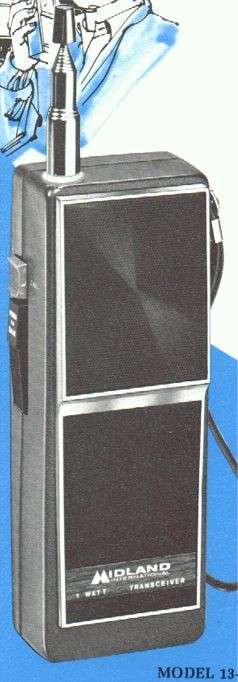



This is the Midland model 13-700. This radio is a 1 Watt, 2 channel walkie-talkie, powered by 8 "AA" batteries. It features a metal case along with Volume, Squelch, PTT/Call Signal, and F1/F2 channel switches. There are also power, charge, and external earphone jacks, and a 5 foot "eyepoker" telescopic antenna as standard equipment. The receiver is a fairly sensitive single conversion super-heterodyne, and the unit came equipped with Channel 11 (fortunately the crystals were plug-in) installed in the "F1" channel position. The transmitter also worked surprisingly well, its performance and range comparing favorably with more powerful handheld units.
I received one of these as a Christmas present in 1973, and it would be my first long term taste of consistent range over 1 mile, after a short-lived experience with a TRC-99c a few months prior. Back in those days, I could routinely reach up to 4 miles (sometimes farther) with this unit, which made it seem more powerful than it was actually rated. This unit performed as well as some 3 and even 5 watt units. This may have had something to do with the l-o-n-g antenna. This radio had one of the longest telescopic antennas of any hand-held radio that I've seen. The greater range of this radio expanded my CB horizons considerably as it gave me the ability to interact with a broader group of people. Having only a 2 channel switch made it a bit cumbersome though, if I wanted to change to a channel that was not currently installed. Fortunately, it only took a turn of a single "dime sized" screw in the middle of the back to remove the cover, and gain access to the crystals. Having a metal case was another plus, as I did occasionally drop my walkie-talkies when running around outside. Mine had a dimple dent in the back corner from one such drop. But it was better than a cracked (or shattered) plastic case. This radio proved to be very popular with the local crowd. Besides myself, at least 3 other local teens ran them for a time, before taking the plunge into full 5 watt, 23 channel radios. I ran mine faithfully for about 7 months before I finally saved up enough cash to buy my first 23 channel CB, a Pace 223.
Unfortunately, I no longer have this radio, as it developed some problems which were traced to the PTT switch contacts wearing out (As a result of a LOT of use no doubt), as well as some other intermittent receiver problems. In a classic example of poetic justice, I had sold the radio to Steve. Shortly afterward, it developed an annoying intermittent receiver problem, which Steve was not able to fix. Although it was unintentional on my part, it served as a payback for the flaky TRC-99c that he had sold to me, a year and a half prior. Steve gave the radio back to me and it eventually got relegated to the parts pile. The antenna survived and got transplanted into my older 13-428, 100 mW radio.
In November of 2005, some 31 years later, I purchased another 13-700 from E-Bay to add to my vintage radio collection. This unit was nearly mint in condition, and still worked well. This unit was manufactured even earlier than my original, the date tag showed 1969. The one striking difference between my original and this unit, was the speaker grill. My original sported a black finish, while this "older" radio's grill had a brushed aluminum finish. I purchased this radio for two reasons. One was the obvious nostalgic sentimental value. The other reason was to perform some objective tests on it to hopefully validate and quantify my years earlier observation that this radio worked nearly as well as a 3 or 5 watt radio. When I received the radio, I had to spray the controls and switches with tuner cleaner to remove the corrosion of age. I then performed a tune-up alignment to bring it up to its maximum level of performance. I then ran a simple test. Using a field strength meter, I made an "A-B" comparison between this radio and my TRC-210, 5 watt handheld radio. According to the FS meter, the Midland produced a reading which was stronger than the TRC-210 on low power, but slightly less than the RS radio on high power. That somewhat confirms my earlier observations, and further testing is planned, including some on-air comparisons with a competent local. It is worth mentioning that this test was performed on a 12V regulated power supply. Performance on batteries might be skewed even further in the Midland's favor, since the current demand is likely to be less.